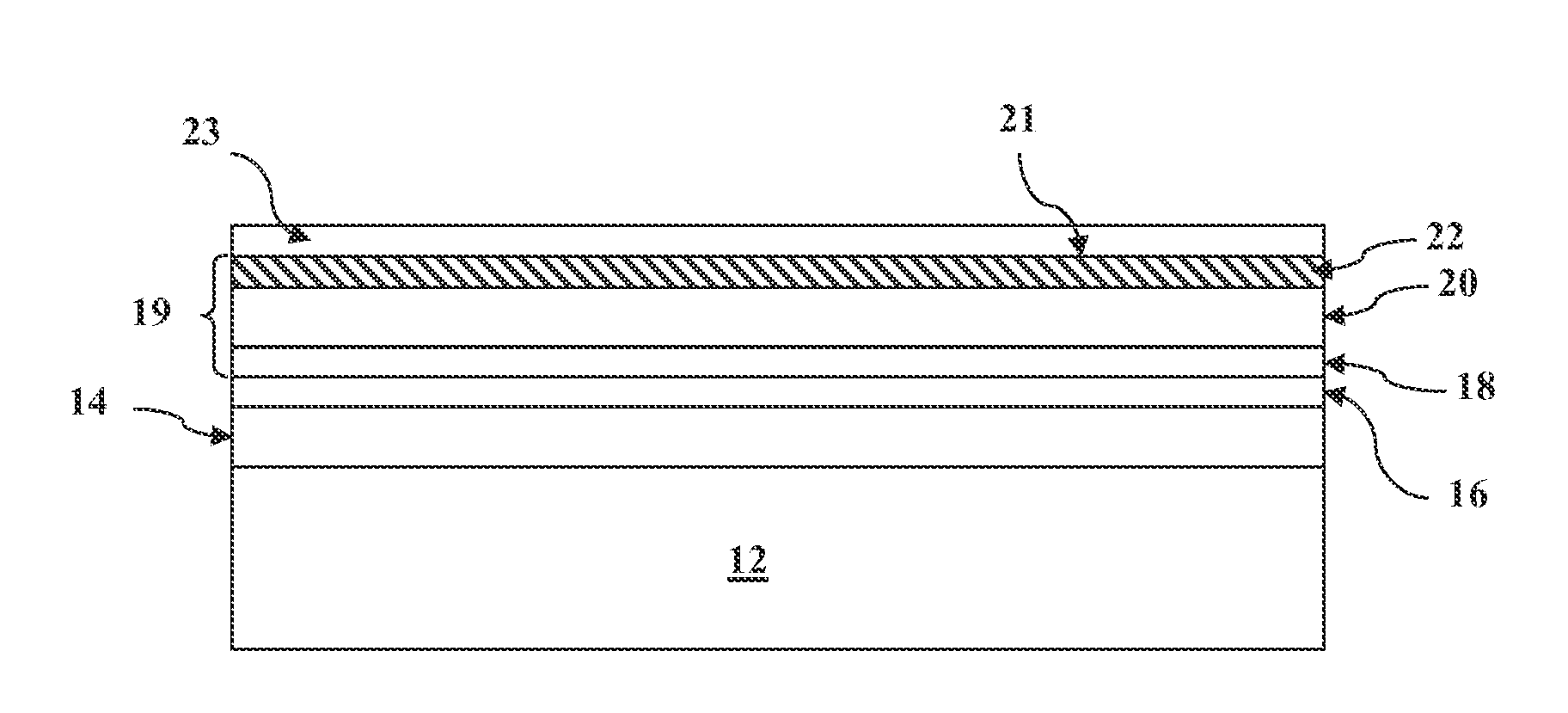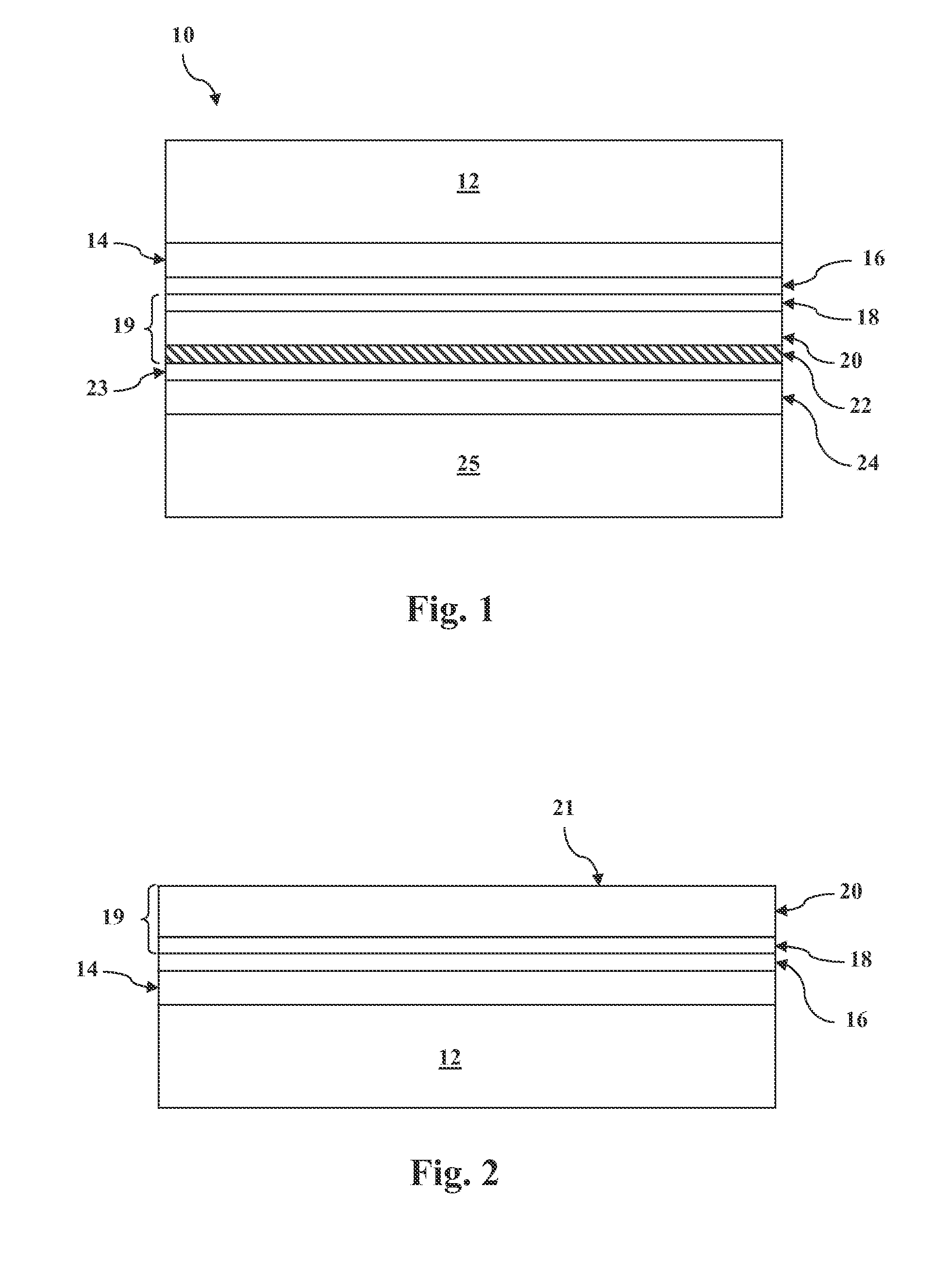METHOD OF CONTROLLING THE AMOUNT OF Cu DOPING WHEN FORMING A BACK CONTACT OF A PHOTOVOLTAIC CELL
a photovoltaic cell and back contact technology, applied in the field of controlling the amount of cu doping when forming a back contact of a photovoltaic device, can solve the problems of deterioration of solar cell efficiency, graphite-paste back contacts are not generally viewed as suitable, and the back contacts of conventional metals are not generally suitabl
- Summary
- Abstract
- Description
- Claims
- Application Information
AI Technical Summary
Benefits of technology
Problems solved by technology
Method used
Image
Examples
example 1
[0066]Mixtures of CuCl2 and CdCl2 were sprayed (20 sec) onto the exposed surface of the p-type absorber layer according to the following concentrations: (1a) 37.5 g / L CdCl2 and 0.1 g / L CuCl2; (1b) 75 g / L CdCl2 and 0.1 g / L CuCl2; (1c) 150 g / L CdCl2 and 0.1 g / L CuCl2; and (1d) 150 g / L CdCl2 and 0.05 g / L CuCl2.
[0067]Samples were annealed at either 175° C. or 185° C. for 20 minutes, first condition was also annealed at 200° C. for 10 minutes. The samples were then rinsed and an inert graphite layer and metal layer were applied. As a control, a sample was annealed with CuCl2 (1.8 g / L at 175° C. for 20 minutes) and an inert graphite and metal layer were applied.
[0068]The highest efficiency (about 13.7%) and fill factor (about 72-73) was obtained with sample 1c (150 g / L CdCl2 and 0.1 g / L CuCl2 annealed at 185° C.). Fill factor appeared to increase with increase in CdCl2 concentration and higher Cu concentration. Voc appeared to increase with higher temperature and lower Cu concentration.
example 2
[0069]Mixtures of CuCl2 and MnCl2 were sprayed (20 sec) onto the exposed surface of the p-type absorber layer according to the following concentrations: (2a) 26 g / L MnCl2 and 0.1 g / L CuCl2; (2b) 26 g / L MnCl2 and 0.45 g / L CuCl2; (2c) 105 g / L MnCl2 and 0.1 g / L CuCl2; and (2d) 150 g / L MnCl2 and 0.1 g / L CuCl2.
[0070]Samples were annealed at either 175° C. or 185° C. for 20 minutes. The samples were then rinsed and an inert graphite layer and metal layer were applied. As a control, a sample was annealed with CuCl2 (1.8 g / L at 175° C. for 20 minutes) and an inert graphite and metal layer were applied.
[0071]The highest efficiency was obtained with samples 2c and 2d annealed at 185° C. At 175° C., the highest performing condition was 2b.
example 3
[0072]Mixtures of CuCl2 and ZnCl2 were sprayed (20 sec) onto the exposed surface of the p-type absorber layer according to the following concentrations: (3a) 30.5 g / L ZnCl2 and 0.45 g / L CuCl2; (3b) 30.5 g / L ZnCl2 and 0.1 g / L CuCl2; (3c) 121 g / L ZnCl2 and 0.1 g / L CuCl2; and (3d) 150 g / L ZnCl2 and 0.1 g / L CuCl2.
[0073]Samples were annealed at either 175° C. or 185° C. for 20 minutes. The samples were then rinsed and an inert graphite layer and metal layer were applied. As a control, a sample was annealed with CuCl2 (1.8 g / L at 175° C. for 20 minutes) and an inert graphite and metal layer were applied.
[0074]The highest efficiency was obtained with samples 3a, for both annealing temperatures. Fill factor increased with increase in CuCl2 concentration and temperature, decrease in ZnCl2 concentration. Voc increased with decrease in CuCl2 concentration and increase in ZnCl2 concentration. Voc's higher for lower ZnCl2 concentrations and 0.45 g / L CuCl2 were almost equivalent to higher ZnCl2 c...
PUM
| Property | Measurement | Unit |
|---|---|---|
| concentration | aaaaa | aaaaa |
| concentration | aaaaa | aaaaa |
| concentration | aaaaa | aaaaa |
Abstract
Description
Claims
Application Information
 Login to View More
Login to View More - R&D
- Intellectual Property
- Life Sciences
- Materials
- Tech Scout
- Unparalleled Data Quality
- Higher Quality Content
- 60% Fewer Hallucinations
Browse by: Latest US Patents, China's latest patents, Technical Efficacy Thesaurus, Application Domain, Technology Topic, Popular Technical Reports.
© 2025 PatSnap. All rights reserved.Legal|Privacy policy|Modern Slavery Act Transparency Statement|Sitemap|About US| Contact US: help@patsnap.com



